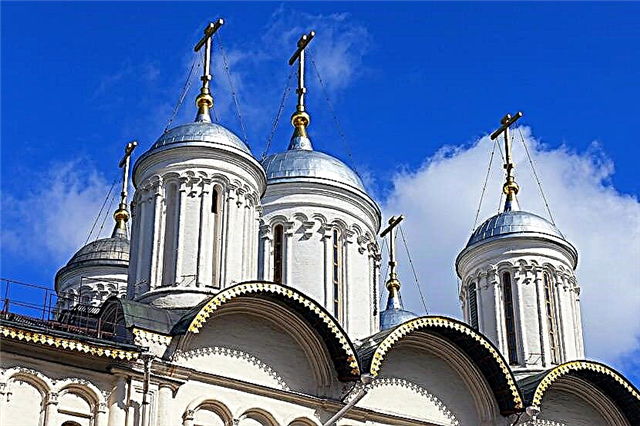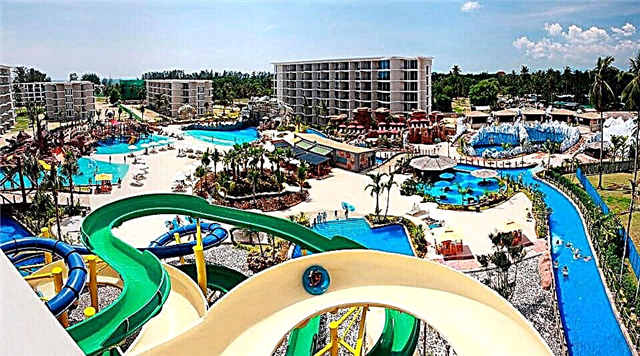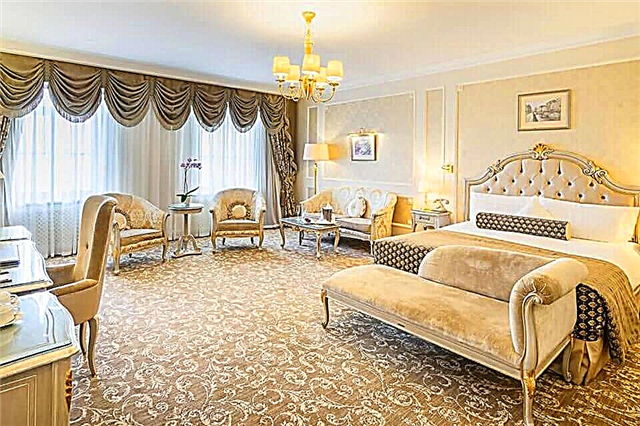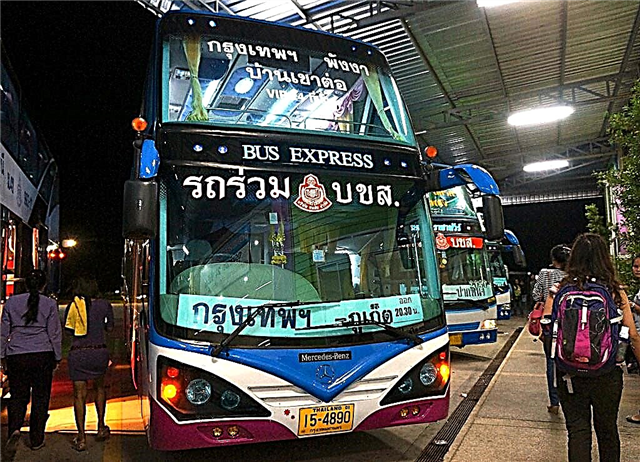Address: Russia, Moscow, Cathedral Square of the Moscow Kremlin
Start of construction: 1635 year
Completion of construction: 1656 year
Coordinates: 55 ° 45'05.0 "N 37 ° 37'02.4" E
Content:
The Patriarch's Chambers Complex is a magnificent architectural monument of the mid-17th century on the territory of the Moscow Kremlin. It includes the palace where the residence of the hierarchs of the Russian Orthodox Church was located, and their home church of the Twelve Apostles. The Patriarchal Chambers close the Cathedral Square from the north.
History of the Patriarchal Compound in Moscow
The first Moscow house for the head of the Russian Church, Metropolitan Peter, was built during the reign of Ivan Kalita in 1325. All the original buildings, like the entire Kremlin then, were wooden.

View of the Patriarchal Palace and the Cathedral of the Twelve Apostles from Cathedral Square
Stone buildings for church hierarchs began to be built under Metropolitan Jonah. It was he who ordered the erection in 1450 of a special chamber next to the Church of the Deposition of the Robe. In 1493, the rebuilt metropolitan courtyard could not withstand a terrible fire, from which most of the Kremlin buildings were damaged. And it was decided to restore the courtyard.
A major restructuring of the church residence was carried out in 1652-1656, and Patriarch Nikon supervised it. He attracted to the construction the most famous architects of that time Antip Konstantinov and Bazhen Ogurtsov, recognized masters of stone tent construction. And to paint the interior, Nikon invited famous painters from the Trinity-Sergievsky Monastery, Yaroslavl and Kostroma. The most complex works were performed by tsarist artists - Simon Ushakov, Iosif Vladimirov and Fyodor Kozlov. But, unfortunately, that early painting has not survived to this day.
The newly rebuilt three-story patriarchal courtyard was not inferior to the Tsar's Terem chambers in beauty, luxury and splendor of interiors. And in its interior was kept a rich patriarchal sacristy - a real treasury. Soon Nikon fell out of favor and during the trial was accused of excessive pride and a desire to catch up with the sovereign himself.
A little bit later, under the leadership of Patriarch Joachim, a new church was built, consecrated in September 1681 in honor of the Twelve Apostles... Instead of the Church of the Robe, which had been performing these functions for more than two centuries, the new cathedral became a home temple for church hierarchs.

View of the Cathedral of the Twelve Apostles
Patriarchal Palace in the XVIII-XX centuries
At the very beginning of the 18th century, under Peter I, the patriarchate was abolished. And the church estates in the Moscow Kremlin began to slowly decay. In 1718, the tsar visited the Patriarchal Palace and ordered to build a library of rare handwritten and printed books on its top floor.
At the beginning of the 18th century, the building of the Patriarch's Chambers was repeatedly reconstructed and rebuilt. In 1722-1725. these works were supervised by the architect Ivan Zarudny. The second floor was highlighted with a wooden ceiling in the temple. A library was placed at the top, and a sacristy in the living quarters of the chambers. A new wooden carved iconostasis with gilding was made for the church. And its walls were painted with oil paints by the famous artist Ivan Zherebtsov.
In the middle of the 19th century, the next reconstruction of the Church of the Twelve Apostles was carried out, led by the architect Dmitry Chichagov. The wooden ceiling between the first and second floors was removed, the cathedral was covered with fresh murals, the decor on the outside was changed and a new large iconostasis was installed on the entire wall. The temple itself was made much lighter, having cut the old window openings and made new ones. And the Patriarch's Palace housed various services of the Synod.
The fighting in the days of the November events of 1917 did not bypass the building of the Patriarchal Palace. Artillery shells significantly destroyed the church and the wall of the refectory. A year later, all the Kremlin buildings were nationalized, and commandant's offices, museum warehouses and restoration workshops were located in them. The Patriarchal Chambers became accessible to all only in 1961, after extensive restoration work.

Architectural features
The three-story building of the Patriarchal Palace was huge for its time. With its construction, the formation of the main architectural ensemble of the Cathedral Square of the Moscow Kremlin was completed. Under Nikon, previously scattered buildings were united into a single architectural block. And the Cathedral of the Twelve Apostles has organically merged into the unified style of the building.
Of course, in the external decor, the Patriarchal Palace took over a lot from the earlier Kremlin buildings. For example, the drums of the Temple of the Twelve Apostles are similar to similar architectural elements of the Archangel Cathedral. And the southern facade of the building echoes the decoration of the older Assumption Church.
If you look closely at the white-stone portal of the church overlooking the square, it is easy to imagine the bypass gallery that surrounded it in the old days. Many parts of the palace have noticeable architectural inconsistencies. This is due to multiple alterations and reconstructions of its facades and internal premises. So, for several centuries, all types of buildings of Medieval Russia have been preserved in the integral complex of chambers - from ceremonial premises to small residential halls. But today the entire architectural ensemble of the Patriarchal Palace, on which the most famous Russian architects have worked for several centuries, looks holistic and harmonious. And the obvious asymmetry of the window openings makes the building only more picturesque.

Cathedral domes
Unique museum exposition
For visitors, the interior decorations and museum collections of the Patriarchal Palace and the Church of the Twelve Apostles are available daily, except Thursday, from 10.00 to 17.00. The second floor, where the ceremonial premises were previously located, is a unique museum collection of works of decorative and applied art and everyday life of the 17th century.
In the front hallway there are items that were used on a daily basis by Patriarch Nikon, as well as his church vestments. In the premises of the Cross Chamber, where church cathedrals and ceremonial receptions were held, you can now see a collection of ancient dishes, as well as items that Tsar Ivan the Terrible used during the hunt, and a unique collection of antique clocks.
In the Prikaz Chambers, visitors have the opportunity to see perfectly preserved chess and writing instruments of Peter the Great's father, Tsar Alexei Mikhailovich. And also a primer specially made for the son of Peter I - Tsarevich Alexei by the famous iconographer and writer of that time Karion Istomin. In the Priory Chambers, the decor of the living room is reproduced, where authentic objects of the 17th century are exhibited: tables, chairs, an armchair, chests, benches and a magnificently made stove, lined with painted tiles.
The refectory chamber exhibits an exhibition of old facial and ornamental sewing. Most of the works of art presented here are objects of church utensils: covers on thrones and altars, shrouds that adorned the walls of churches, shroud and curtains of the royal gates. The Cathedral of the Twelve Apostles presents rare signed icons of the 17th century, created by artists from Moscow and other cities of Russia.

View of the Patriarchal Palace and the Cathedral of the Twelve Apostles from Ivanovskaya Square
And among them are the works of the famous masters of the brush of that time Fyodor Zubov and Simon Ushakov. Restoration work in the complex of the Patriarch's Chambers is ongoing. So, in 2013, the masters cleared away fragments of wall painting of the 17th century in the ceremonial hallways and the Prikaz chambers.
All items that can be seen inside the Patriarchal Palace and Cathedral are genuine things of the royal, boyar and patriarchal everyday life. They make it possible to easily imagine the medieval capital of Russia and its Kremlin, and feel the spirit of that era.An excursion to this unique museum allows you to touch one of the turning points in Russian history - the 17th century, which brought a lot of new things into the culture and traditions of our country.











